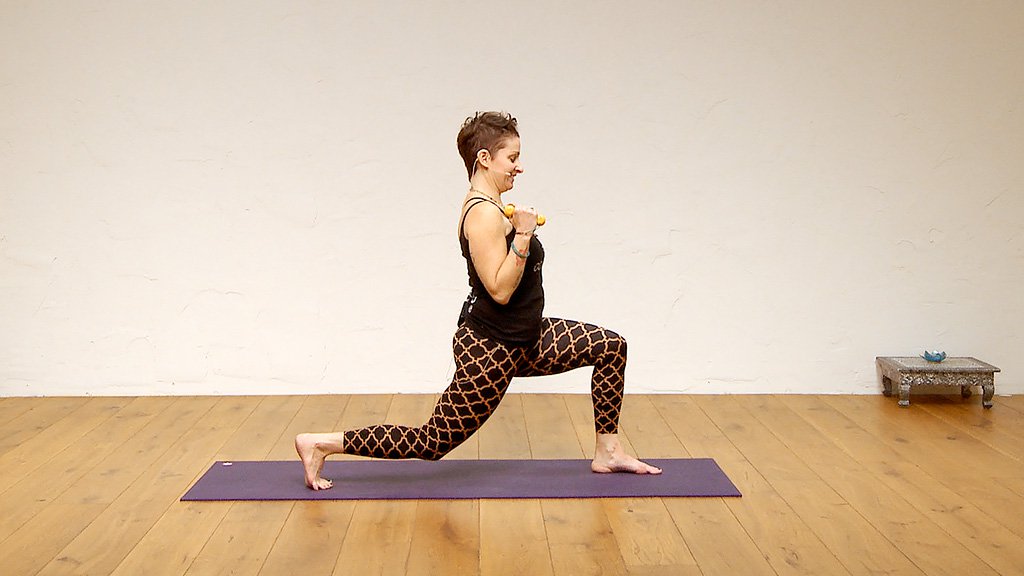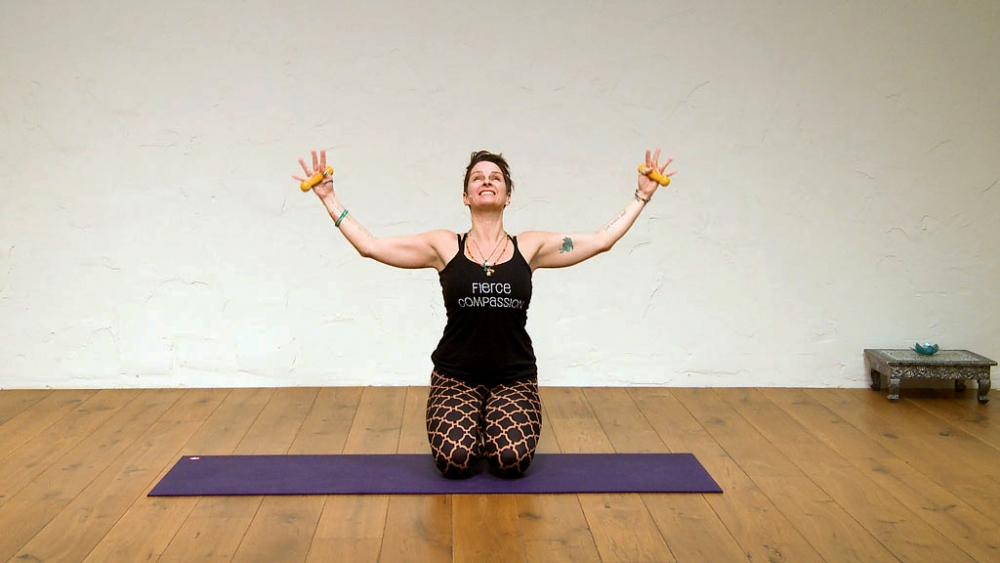As many of you know from my fun and creative Yoga with Weights classes, I’m a big fan of adding light (3-5lb) hand weights to many yoga postures during asana practice. I love the way hand weights add an extra element of strength, stamina and body awareness to the already challenging postures I have been practicing regularly for years.
The focus on my breath is intensified and my experience of body-mind synchronization is heightened when I add weight training to my yoga practice (which ensures safe, smooth, and graceful movements). For me, Hatha-Vinyasa yoga is about the dynamic balance of strength and suppleness – I find that adding extra weight to certain yoga postures increases the strength portion of this yogic dance.
Practising yoga with weights will:
1. Improve the health and longevity of your bones
Bones are living tissues and respond very well to healthy stress. Adding hand weights increases the load we bear on our bones and therefore helps the bones in their ability to remodel. As we age our bones get more and more porous*. In addition to walking, jogging, dancing and climbing stairs, weight bearing yoga postures such as Table Top, High Lunge, Warrior 1, Warrior 2, and Warrior 3, Tree pose, and Side Planks can help to increase bone density…and adding extra weight to these postures can help even more!
*Read more about this in Osteopenia osteoporosis and yoga

2. Strengthen and improve the efficiency of the heart
In order to strengthen the cardio muscle tissue of the heart and to increase the efficiency of the cardiovascular system, it is recommended to perform thirty minutes of cardio exercise three times a week: jog, cycle, row, dance or other aerobic exercises such as these.
In addition to strengthening muscles and bones, anaerobic resistance training (carbohydrate-burning exercises that resist gravity, such a lifting weights) also offers many cardiovascular benefits. By increasing the weight a joint has to propel through space and time, the heart is challenged to increase the blood flow to the active muscles, which makes the cardio muscle tissue stronger. A strong heart has to work less (in each beat) to pump blood which equates in lowered blood pressure.
Both The American Heart Association and the Centers for Disease Control and Prevention recommend both cardio and strength training at least twice per week each. As a personal trainer, I recommend that on these days you perform 3 sets of ten repetitions of a specific weighted exercise for each muscle/muscle group. (I love 3 days of cardio and 3 days of strength training a week).
3. Increase core strength and joint stability
As we age we lose more and more muscle mass…by the age of 70 we can lose as much as 30-55%! The good news is that by lifting weights we increase our muscle mass, which in turn increases our muscles’ ability to protect, support and stabilize our bone and joints.
As we age we lose more and more muscle mass. By lifting weights we increase our muscle mass, increasing our muscles’ ability to protect, support and stabilize our bone and joints.
Adding weights to yoga postures such as Locust, Boat, Table Top, Gate, Plank and/or Side Plank adds an extra challenge to our core supporting/strengthening muscles (and when I say core I am always referring to the Apple Core Theory of the core…muscles that support the 6 movements of the spine: flexion, extension, lateral flexion R/L and Rotation R/L).
Adding weights to yoga postures such as Tree, Warrior Three, and Extended Big Toe Hold challenges the strength of the muscles that stabilize our hip, knee, ankle and feet joints and also the intrinsic connective tissue (tendons and ligaments) of these joints. If we are more stable we tend to stumble and fall less. If we are strong and supple and still fall, our ability to eccentrically contract (a technique used in resistance training where the muscle is strengthened even as it lengthens) prevents the tendency to crash and injure ourselves because our landings are lighter and more controlled.
4. Keep us leaner and lighter
In addition to all the other amazing benefits of adding weight training to our yoga practice, it is a well-known fact that muscles burn more calories than fat.
In addition to all the other amazing benefits of adding weight training to our yoga practice, it is a well-known fact that muscles burn more calories than fat.
Increasing your muscle to fat ratio can ensure that your active muscles are burning more calories throughout your day. This can help you maintain a healthy weight, which is always good for our joints! Practising Mula- and Uddiyana Bandhas will also keep us lighter on this earth.
Mula Bandha (root lock) is the toning of the pelvic floor muscles and Uddiyana Bandha (upward flying lock) is the toning of the diaphragm, the major muscle of breathing. Adding weights to our yoga practice adds an extra challenge to these muscles and muscle groups if we are consciously aware of activating and lifting as we practice. This increases the bandhas’ efficiency and optimal performance of lifting Prana up into the body and keeping us light, adding to our overall radiant health and longevity.
Yoga classes with weights playlist
EkhartYoga members can practice more yoga with weights classes by following this playlist created by Jennilee.

